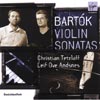Bartók Violin Sonatas
Perceptive violin playing and some of the finest Bartók piano playing on disc
View record and artist detailsRecord and Artist Details
Composer or Director: Béla Bartók
Genre:
Chamber
Label: Virgin Classics
Magazine Review Date: 9/2004
Media Format: CD or Download
Media Runtime: 79
Mastering:
Stereo
DDD
Catalogue Number: 545668-2

Tracks:
| Composition | Artist Credit |
|---|---|
| Sonata for Violin and Piano No. 1 |
Béla Bartók, Composer
Béla Bartók, Composer Christian Tetzlaff, Violin Leif Ove Andsnes, Piano |
| Sonata for Violin and Piano No. 2 |
Béla Bartók, Composer
Béla Bartók, Composer Christian Tetzlaff, Violin Leif Ove Andsnes, Piano |
| Sonata for Solo Violin |
Béla Bartók, Composer
Béla Bartók, Composer Christian Tetzlaff, Violin |
Author: Rob Cowan
Would it, I wonder, betoo fanciful to divide interpreters of Bartók’s violin music into two approximate categories: Szigeti-Végh and Menuhin-Stern? In other words, cerebral-rustic and emotive-universal? Listen to Thomas Zehetmair’s Bartók or Isabelle Faust’s, Gidon Kremer’s or indeed Christian Tetzlaff’s and the spirit of Végh in particular seems prominent. Whereas Eugene Drucker, György Pauk and Robert Mann (on Bartók Records) are more aligned with Menuhin and Stern.
Tetzlaff’s tone is grainy and lightly-brushed, his inward approach most evident in the Solo Sonata, a work he plays with sovereign command – and with greater freedom than on his more straightlaced 1991 recording (Virgin, nla), which veered less towards the Végh axis than this new version does. Here Tetzlaff makes more of the fugue’s shifting perspectives and relishes Bartók’s bold chord constructions. And I’ve rarely been more aware of how much the closing presto resembles the coda of the Second Violin Concerto, a connection that Tetzlaff traces more deftly than most. Other players may at times employ a richer tone palette but few take a more thoughtful interpretative standpoint on what is after all the finest unaccompanied violin sonata since Bach.
The two duo sonatas are also beautifully done. Tezlaff again proves both focused and expressive, though among modern rivals I retain a special fondness for Faust’s questing expressiveness, and György Pauk’s Naxos coupling offers honest musical reportage. But for me what makes these performances more or less indispensable is the character and control of Leif Ove Andsnes’s piano playing, its fastidious deployment of tone and immaculate timing. The clarion alarms in the outer movements of the First Sonata, where tonality is stretched to its limits, ring out without percussive overkill. The Second Sonata’s folksy Allegretto is strong and tidy but with the unmistakable sense of earth under foot. Andsnes is the stronger personality, Tetzlaff the more confidential, yielding presence (wonderful in the First Sonata’s Adagio); an ideal anima-animus performing relationship.
This is chamber music playing of the highest order, candid and straightforward enough for a basic library recommendation but also rich enough in subtleties to satisfy even the most discerning connoisseur.
Tetzlaff’s tone is grainy and lightly-brushed, his inward approach most evident in the Solo Sonata, a work he plays with sovereign command – and with greater freedom than on his more straightlaced 1991 recording (Virgin, nla), which veered less towards the Végh axis than this new version does. Here Tetzlaff makes more of the fugue’s shifting perspectives and relishes Bartók’s bold chord constructions. And I’ve rarely been more aware of how much the closing presto resembles the coda of the Second Violin Concerto, a connection that Tetzlaff traces more deftly than most. Other players may at times employ a richer tone palette but few take a more thoughtful interpretative standpoint on what is after all the finest unaccompanied violin sonata since Bach.
The two duo sonatas are also beautifully done. Tezlaff again proves both focused and expressive, though among modern rivals I retain a special fondness for Faust’s questing expressiveness, and György Pauk’s Naxos coupling offers honest musical reportage. But for me what makes these performances more or less indispensable is the character and control of Leif Ove Andsnes’s piano playing, its fastidious deployment of tone and immaculate timing. The clarion alarms in the outer movements of the First Sonata, where tonality is stretched to its limits, ring out without percussive overkill. The Second Sonata’s folksy Allegretto is strong and tidy but with the unmistakable sense of earth under foot. Andsnes is the stronger personality, Tetzlaff the more confidential, yielding presence (wonderful in the First Sonata’s Adagio); an ideal anima-animus performing relationship.
This is chamber music playing of the highest order, candid and straightforward enough for a basic library recommendation but also rich enough in subtleties to satisfy even the most discerning connoisseur.
Discover the world's largest classical music catalogue with Presto Music.

Gramophone Digital Club
- Digital Edition
- Digital Archive
- Reviews Database
- Full website access
From £8.75 / month
Subscribe
Gramophone Full Club
- Print Edition
- Digital Edition
- Digital Archive
- Reviews Database
- Full website access
From £11.00 / month
Subscribe
If you are a library, university or other organisation that would be interested in an institutional subscription to Gramophone please click here for further information.




